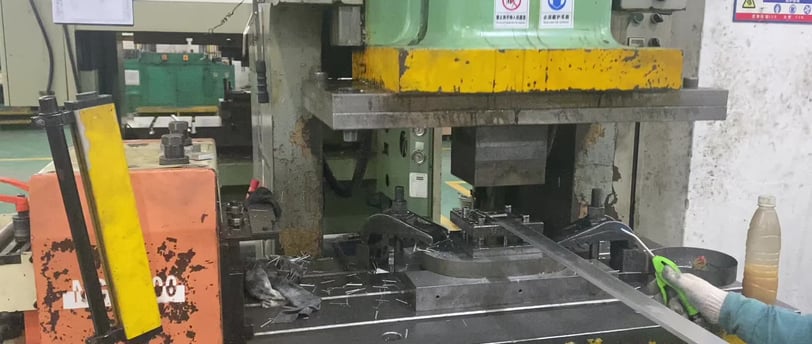Stamping Die Common Fault Diagnosis and Repair Skills
3/3/2025


Understanding Stamping Dies
Stamping dies are essential tools in the manufacturing industry, specifically in the metal forming processes. These dies enable the shaping, cutting, and forming of materials using a stamping press, essentially allowing for the production of parts in varying shapes and sizes. The primary components of a stamping die typically include the die body, the punches, and the die halves, each element meticulously designed to ensure accurate production.
There are several types of stamping dies, each tailored for specific manufacturing needs. Progressive dies are one prevalent type, used to perform multiple operations in a single pass. This type of die allows for a continuous supply of metal, where the material moves through a series of stations that progressively shape and cut it into the desired form. Compound dies, another common type, execute multiple operations simultaneously, making them efficient for simple parts that do not require extensive shaping. Lastly, transfer dies function by moving the metal part between different stations, allowing for complex designs and operations, particularly in high-volume production settings.
The materials used to construct stamping dies vary, but high-carbon steel and tool steel are commonly preferred due to their durability and ability to withstand significant pressure. Additionally, precision in the engineering of stamping dies cannot be overstated; fines in tolerances can lead to defects in the final product or even cause failures during the stamping process. As such, it is imperative for manufacturers to invest in well-designed and expertly crafted stamping dies to ensure efficiency, reduce material waste, and maintain high-quality standards in production. Understanding these various aspects of stamping dies is crucial for professionals in the industry aiming for operational excellence.
Common Faults in Stamping Dies
Stamping dies play a critical role in the manufacturing sector, particularly in the production of metal parts and components. However, various common faults can occur during their operation, which may adversely affect both product quality and production efficiency. Understanding these issues is essential for timely diagnosis and effective repair.
One of the primary problems encountered with stamping dies is wear and tear. Over time, the repeated action of stamping can lead to gradual deterioration of the die materials. This preservation issue is usually marked by diminished sharpness or a reduction in the die's structural integrity. The materials used in die construction can also influence wear rates; for instance, softer materials may wear faster compared to those made from high-precision steel.
Misalignment is another prevalent fault associated with stamping dies. This issue generally arises when the die components are not correctly aligned during assembly or setup, leading to uneven pressure distribution during the stamping process. Signs of misalignment could include uneven stamping results or increased operational noise. This misalignment can not only compromise the accuracy of the stamped components but also potentially cause premature die wear.
Breakage of the stamping die components represents a serious operational challenge, often resulting from excessive force during the stamping process or improper handling during maintenance. Detectable signs of potential breakage may include unusual vibrations, audible cracking noises, or visible damage upon inspection. Such breakage can significantly increase downtime and repair costs if not addressed promptly.
Lastly, surface imperfections often manifest as cosmetic flaws or functional defects on the stamped products. These may be caused by inadequate lubrication, contaminants, or poor die finish. Surface imperfections can lead to issues such as poor product adhesion, leading to significant disruptions in the production line.
Diagnosis Techniques for Stamping Die Issues
Diagnosing faults in stamping dies is crucial for sustaining optimal production efficiency and product quality. An effective diagnosis begins with comprehensive visual inspections, which play a pivotal role in identifying visible signs of wear, deformation, or damage to the die. During these inspections, operators must keenly observe the die surfaces for any inconsistencies, such as scratches, corrosion, or misalignment, which can impair performance and lead to defective products.
In addition to visual assessments, precise measurements using calipers and gauges are essential for validating the integrity and dimensions of stamping dies. Calipers can accurately measure critical parameters, such as thickness, width, and depth, ensuring that the die meets the necessary specifications. Similarly, gauges can be employed to determine the die's fit, clearance, and alignment. These measurements are instrumental in ascertaining whether the die has undergone unintended changes due to wear or operational stress.
Another effective diagnostic technique involves stress analysis, which entails evaluating the die’s performance under operational conditions. This can often be achieved through finite element analysis (FEA) methods, allowing engineers to visualize stress distribution and pinpoint areas susceptible to failure. By subjecting the die to simulated forces and loads, stakeholders can predict potential issues before they manifest, thereby preventing costly downtime.
Systematic documentation throughout the diagnosis process cannot be overstated. Record-keeping should encompass all findings from inspections, measurements, and analyses. This documentation serves as a valuable resource for future reference, troubleshooting, and identifying recurring issues. Furthermore, establishing a regular maintenance schedule is imperative to ensure that stamping dies are consistently monitored and serviced. By adhering to these practices, manufacturers can mitigate the risk of unforeseen die malfunctions and prolong the lifespan of their tooling equipment.
Repair and Maintenance Strategies
Effective repair and maintenance strategies are crucial for ensuring the longevity and optimal performance of stamping dies. Regular inspection of stamping die components can significantly help identify wear or damage early, allowing for timely interventions and reducing overall repair costs. One effective technique for reconditioning worn components is the process of surface grinding, which restores the flatness of surfaces that have been compromised. Additionally, any worn edges can be sharpened or built up with welding materials where appropriate, enhancing the die's functionality.
Aligning dies correctly is vital for achieving consistent stamping results. Misalignment can lead to excessive wear and machining errors, which could ultimately result in product defects. Utilizing alignment tools, such as dial indicators and goes/no-go gauges, can facilitate precise adjustments. When substituting broken elements, it is important to select compatible replacement parts that meet the manufacturer’s specifications to maintain the intended design and performance of the die.
Preventive maintenance plays a key role in minimizing the risk of future faults. Adopting best practices for proper storage is essential; dies should be stored in a clean, dry environment to prevent corrosion and damage from environmental factors. Regular cleaning of dies after each use with appropriate solvents can help eliminate debris that can cause wear over time. Furthermore, lubricating moving parts with high-quality lubricants reduces friction and guides smoother operation, thereby extending the life of the die.
While many maintenance tasks can be performed in-house, certain advanced repairs may require professional expertise. Signs such as extensive wear or complex operational issues often necessitate consulting specialists who possess the knowledge and equipment necessary for sophisticated repairs. By implementing these repair and maintenance strategies, one can enhance the efficiency and reliability of stamping dies, ensuring optimal production output.
